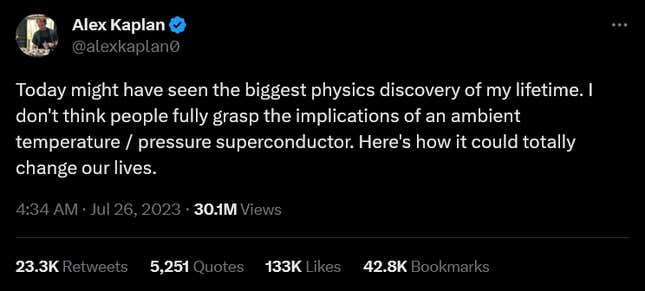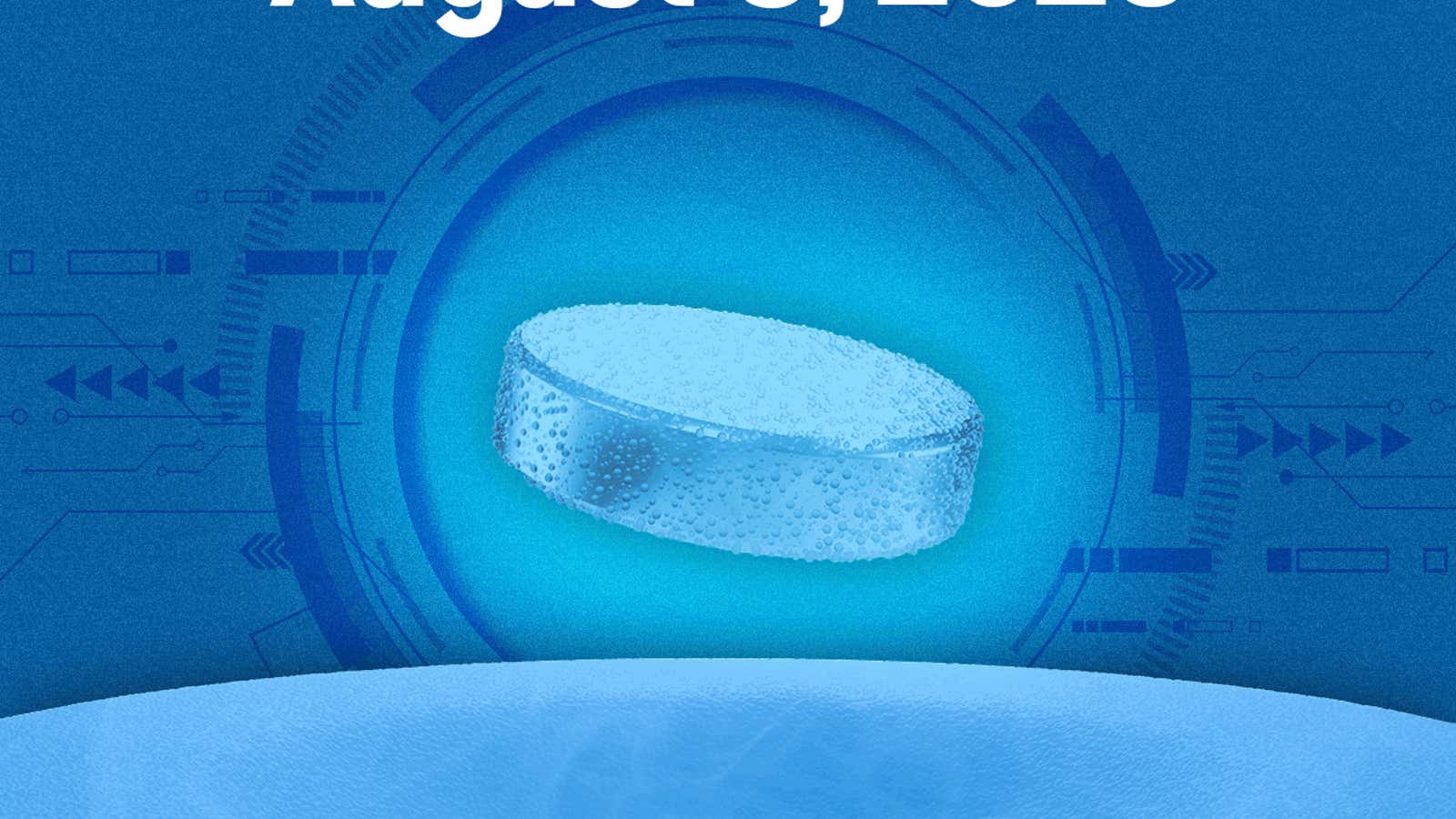Hi Quartz members!
For a video with the potential to change the world, “Magnetic Property Test of LK-99 Film” has disappointingly few views on YouTube: barely 240,000 views in the last five months. It lasts all of 47 seconds and shows a chip of metal, coated with a material called LK-99, being repelled by both poles of a magnet held by a gloved hand. Without context, it’s mystifying; a cat video has more obvious appeal.
If LK-99 is what it claims to be, though, that video will be enshrined as a historical artifact. The researchers at Quantum Energy Research Center in Seoul, who first made LK-99, have argued that it demonstrates some properties of superconductivity. One of them is the diamagnetism shown in the YouTube video. But as squads of scientists around the world race to replicate those results, the jury is still out on whether LK-99 is a true superconductor: a material that offers no resistance at all to electricity.
To be precise, the storm of excitement (or perhaps hype) is over LK-99's potential to be a room-temperature superconductor. Many other superconductors exist, and indeed are in use already—in MRI machines, for example. But their superconductivity shows up only in very low temperatures or under very high pressures. The superconductors in MRI machines have to be cooled with liquid helium to a temperature of -269°C.
A superconductor that works in ordinary, ambient temperatures and pressures will undoubtedly be revolutionary (more on that below). But just as fascinating as the science of it all is the discourse around the science, which has unfolded breathlessly on social media and the rest of the internet.
Prediction markets took bets on whether LK-99 is legit. arXiv, the database of scientific papers, filled up with preprints about superconductivity. There were memes, naturally. Stocks in Chinese and Korean tech companies surged. Everyone seemed absolutely primed and ready for a silver bullet that will solve the world’s problems.

To be sure, the world has many problems that need solving. But it’s telling that we, as a society, seem to be craving technological miracles to do the job, as if scientific backwardness has been the only thing holding us back from a cleaner planet or a more equitable world. An air of desperation hangs over us as we lunge with open arms at “game-changing,” “revolutionary,” “the-world-will-never-be-the-same-again” developments. Recall that it was AI not very long ago, and the metaverse before that, and decentralized finance before that, and Crispr before that. Even during the pandemic, health authorities had to warn us often that covid vaccines would not be silver bullets.
There’s a distinct danger in believing that new technology will rescue us and make us whole, and that we only need to wait for it to emerge. It induces us to ignore the changes we need to make today. New investments in public transport cannot be postponed until cheap maglev trains are a reality. The future prospects of carbon capture or atmospheric manipulation shouldn’t stop us from cutting fossil fuel use today.
LK-99, or some other material, may well prove to be an ideal, inexpensive room temperature semiconductor, and that will certainly be a red-letter day. But progress comes only at the speed of human effort. The scientists behind LK-99, after all, have been working on the material for a quarter of a century.
KILLER APPS
Five potential applications for a true room-temperature semiconductor:
- A better power grid: The US loses roughly 5% of its electricity while transmitting and distributing it. That isn’t a trivial number: It’s enough to power every Central American country four times over. Consumers pay a collective $6 billion (pdf) every year as a result of these losses. Making electric cables out of superconductors would eliminate that.
- More maglev trains: The levitating effect that scientists are seeking in LK-99 can be built into rail networks without having to cool the superconductors the way Shanghai’s maglev train does.
- Quantum computers: The desktop quantum computer is some way off yet, but a low-cost room temperature semiconductor will make them cheaper and more energy efficient.
- Fusion power: Nuclear fusion plants rely on powerful superconducting magnets, which generate magnetic fields that contain the hot plasma within. Thus far, these magnets have been expensive and temperamental.
- Better batteries: Electric cars could charge in a matter of minutes and travel farther on a single charge, cell phones wouldn’t heat up, and renewable energy could be stored without loss in giant battery silos.
SOME SOCIAL SCIENCE
Not very long ago, the only access we had to a giant scientific discovery was to read about it in a peer-reviewed journal. Now, no longer: Besides the fact that the original LK-99 papers themselves appeared in non peer-reviewed “preprint” form on arXiv, we’re also getting an unprecedented kind of access through social media to the scientific work surrounding LK-99. That’s in part because LK-99 is easy to make, at least for an alleged superconductor.
There are videos, for instance—not only from the team that made LK-99 but also from scientists around the world trying to replicate their results, filming and uploading their trials on Twitter, Twitch, or the Chinese site Bilibili. Individuals and institutions are live-tweeting their experiments. One scientist tweeted out her arXiv paper barely a day after it was submitted, accompanied by a gif of Barack Obama dropping a mic.
One way to see this is as the democratization of science. Another frame for it, though, is as a performance of science for the public. There’s a reason that scientists trying to replicate the original results are posting videos of near-levitating flakes of LK-99. Levitation is not the chief attribute of interest with superconductivity, but sure does look cool.
In contrast, there is still little evidence that LK-99 has zero resistance to electric currents. (Preliminary papers from two Chinese universities found high resistance and zero resistance around -173°C but not conclusively at room temperature.) This data is necessarily technical and textual; it doesn’t lend itself as easily to social media posts. But that’s the data that will determine whether or not LK-99 is a watershed moment in the history of science.
ONE 🏆 THING
A room-temperature superconductor is frequently described as the Holy Grail of solid state physics—a development so titanic that it will transform both the science and the world beyond recognition. Other fields are in pursuit of their own Holy Grails:
⚛️ Cold nuclear fusion, in energy physics: Getting two hydrogen atoms to fuse together, generating vast amounts of clean energy in the process.
🧬 Targeted gene therapy, in medicine: Curing people of diseases by targeting the very genes in their cells that are making them sick.
🧮 Proving the Riemann hypothesis, in mathematics: Proposed by Bernhard Riemann in 1859, the hypothesis deals with a particular function, known as the zeta function. The numbers for which the function works out to zero all follow a pattern, Riemann proposed—and although trial and error have confirmed this, there is no universal proof yet.
🎵 Demixing, in audio engineering: Taking an old mixed recording—in which several tracks had been mixed into a mono or stereo version, as in the case of the legendary recording of The Beatles at the Hollywood Bowl in 1964—and “demixing” it, separating it out again into its constituent tracks.
🤖 Universal object manipulation, in robotics: Building a mechanical arm that can pick up and handle things as well as a human hand.
💲 One-to-one marketing, in retail: Imagine a hard sell personalized for you, and targeted at you when you most need the product—a prospect to make every marketing professional salivate.
Thanks for reading! And don’t hesitate to reach out with comments, questions, or topics you want to know more about.
Have a super weekend,
—Samanth Subramanian, global news editor
